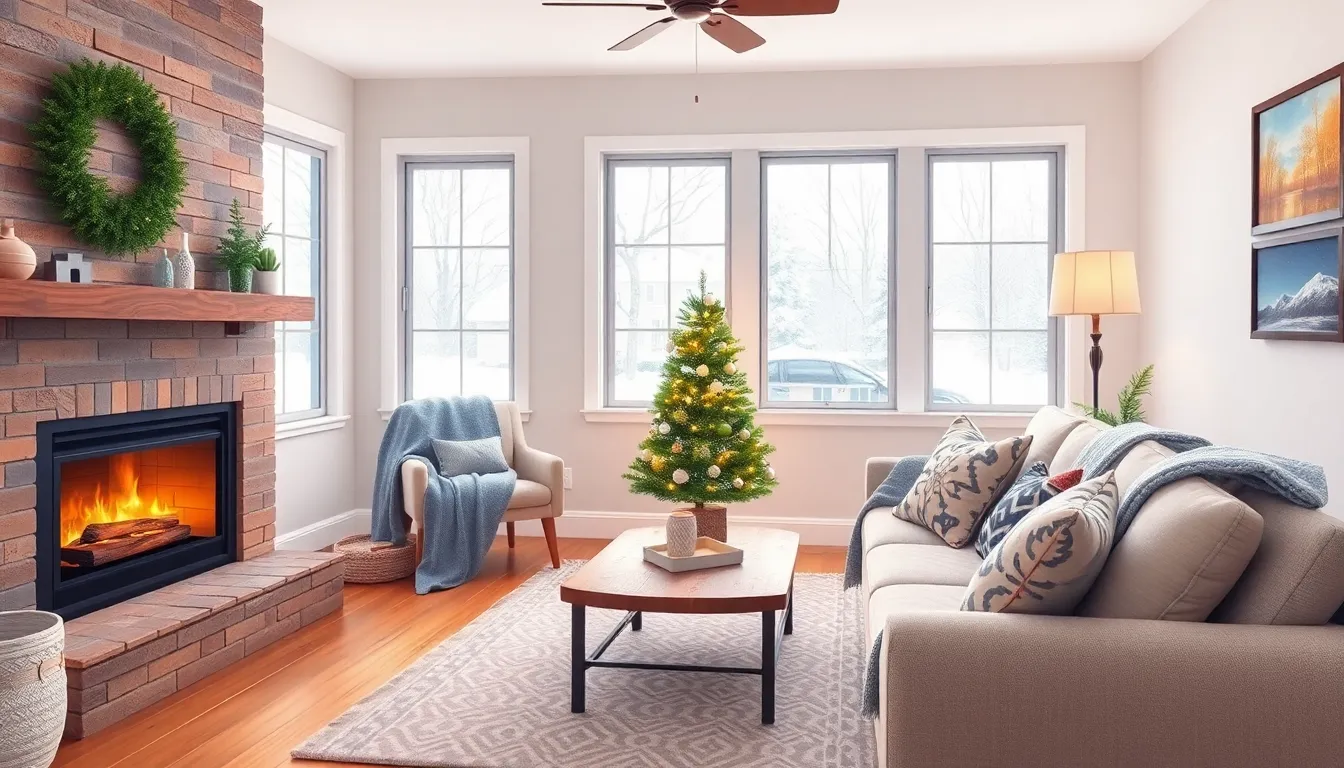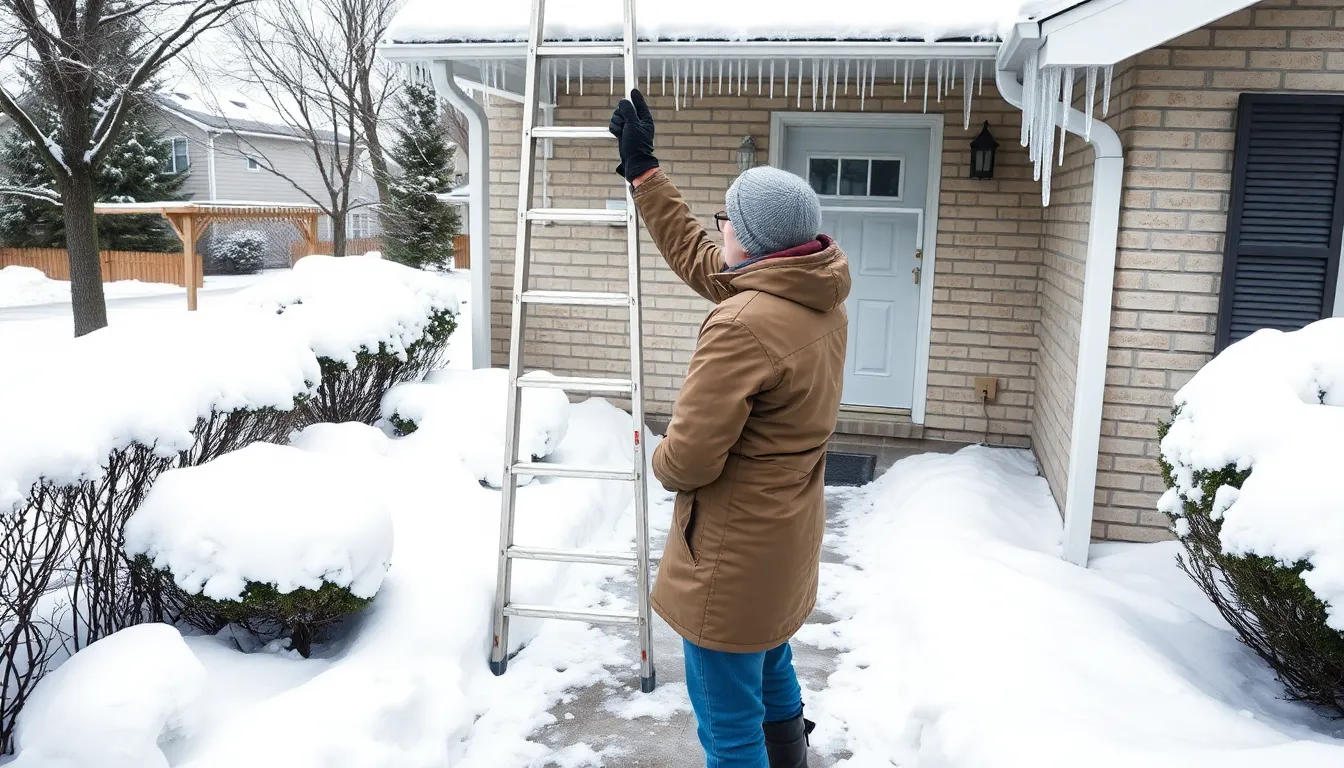As winter rolls in and the temperatures drop, homeowners face a frosty reality: it’s time to tackle that winter home maintenance checklist. Think of it as a survival guide for your house, ensuring it stays cozy while the snow piles up outside. After all, nobody wants to turn their living room into an igloo or discover that their pipes have decided to throw a winter tantrum.
Winter Home Maintenance Checklist
Maintaining a home during winter proves essential for overall comfort and safety. A checklist provides a structured approach, ensuring vital tasks aren’t overlooked. Protection against harsh weather starts with regular inspections of the roof, gutters, and insulation.
Homeowners commonly face issues like blocked gutters, leading to ice dams and potential water damage. Preventing freezing pipes remains a priority, as it can incur expensive repairs. Checking the heating system guarantees reliable warmth throughout the winter months.
Energy efficiency often improves with insulation checks, reducing utility bills. Homeowners benefit from sealing drafts, which enhances indoor comfort and saves money. Safety measures, like testing smoke detectors and replacing batteries, should not be ignored.
Prioritized maintenance tasks help prevent emergencies related to heating and plumbing failures. Addressing outdoor issues, such as pruning trees, minimizes the risk of branches causing damage during storms. Regularly inspecting windows and doors also plays a crucial role in maintaining energy efficiency.
Conducting a thorough maintenance checklist reinforces preparedness for winter challenges. Overall, a proactive approach helps ensure a safe, warm, and comfortable home environment during the cold season. It reduces stress and saves time by avoiding last-minute repairs when temperatures drop.
Interior Maintenance Tasks

Maintaining the interior of a home during winter ensures warmth and safety. Homeowners should focus on essential maintenance tasks to enhance comfort throughout the colder months.
Check Heating Systems
Check heating systems before temperatures drop. Inspect the furnace and ensure it’s in proper working order. Filter replacements may improve efficiency and air quality. A programmable thermostat can optimize energy use and maintain desired temperatures. Schedule a professional service for a thorough inspection, focusing on any unusual noises or odors. Regular maintenance prolongs the lifespan of the system and prevents unexpected breakdowns.
Inspect Insulation
Inspect insulation throughout the home to maintain energy efficiency. Pay attention to areas like attics, basements, and crawl spaces. Proper insulation reduces heat loss and lowers energy bills. Upgrade inadequate insulation materials for better performance and comfort. Seal any gaps around windows and doors to prevent drafts. This proactive approach keeps interiors warm and reduces strain on heating systems.
Test Smoke And Carbon Monoxide Detectors
Test smoke and carbon monoxide detectors regularly to ensure safety. Replace batteries at least twice a year, coinciding with seasonal changes. Check that detectors meet local regulations and standards for functionality. In addition to testing, replace devices older than ten years. Keeping these devices in optimal condition helps prevent emergencies and ensures peace of mind during winter nights.
Exterior Maintenance Tasks
Performing exterior maintenance tasks regularly prevents damage and ensures safety during winter. Homeowners should prioritize these critical tasks to maintain both function and aesthetic appeal.
Clean Gutters And Downspouts
Cleaning gutters and downspouts tackles potential clogs and ice dams. Homeowners need to remove leaves, debris, and other blockages to ensure proper drainage. Maintaining clear gutters helps prevent water damage to the roof and foundation. It’s advisable to conduct this task monthly during fall and winter. Checking downspouts for proper water flow ensures runoff directs away from the home, minimizing risks.
Inspect Roof And Chimney
Inspecting the roof and chimney prevents costly repairs. Homeowners should look for missing or damaged shingles, as these can lead to leaks and water damage. A professional inspection of the chimney identifies cracks or soot buildup. Maintaining both elements helps avoid hazardous situations, especially during snowfall or heavy rain. Addressing small issues promptly keeps roofs and chimneys in good condition throughout winter.
Seal Windows And Doors
Sealing windows and doors provides essential insulation against cold air. Gaps around these openings often allow drafts to enter, leading to higher energy bills. Weather stripping and caulking supply effective solutions to enhance energy efficiency. Homeowners can also consider thermal curtains for additional insulation. Regular checks ensure that seals remain intact, creating a comfortable indoor environment throughout winter.
Preparing For Severe Weather
Severe winter weather demands specific preparations. Homeowners must take proactive steps to stay safe and minimize damage.
Stock An Emergency Kit
Stocking an emergency kit includes essential supplies for unexpected scenarios. Include water, non-perishable food, and flashlights to ensure basic needs are met. First-aid kits, blankets, and batteries are crucial for warmth and health during outages. A battery-powered radio can provide updates on weather conditions and emergencies. Don’t forget to add medications and personal documents for convenience. Keeping this kit accessible and regularly checking expiration dates ensures readiness when severe weather strikes.
Winterize Outdoor Equipment
Winterizing outdoor equipment helps prevent damage from freezing temperatures. Drain hoses and store them indoors to avoid cracking. For lawnmowers and similar tools, remove fuel to prevent clogs in the engine. Clean and cover patio furniture to protect against harsh weather conditions. Inspect snow shovels and ice scrapers for functionality, ensuring they’re readily available when significant snowfall occurs. Finally, check the status of outdoor lighting to enhance safety during long winter nights. Proper preparation of outdoor equipment boosts longevity and functionality.
Seasonal Safety Tips
Homeowners must prioritize safety during winter months. Implementing specific measures protects both residents and property from the challenges that come with cold weather.
Keep Walkways Clear
Keeping walkways clear of snow and ice reduces slipping hazards. Regular shoveling after each snowfall ensures safe access to entry points. Applying salt or sand enhances traction on icy surfaces. Setting a schedule for this task helps maintain safety throughout winter. Homeowners should also plan for high-traffic areas where snow typically accumulates. Installing an outdoor mat can prevent excess moisture from entering the home. Lastly, consider arranging for snow removal services if mobility poses a challenge.
Review Fire Safety Plan
Reviewing a fire safety plan is essential during winter. Homeowners should ensure that smoke detectors are working correctly, testing them monthly and replacing batteries as needed. Having a fire extinguisher readily available in the kitchen and near potential hazards like fireplaces is crucial. Creating and practicing an emergency escape plan guarantees everyone knows how to respond in case of a fire. Discussing evacuation routes and designated meeting points with family members builds preparedness. Additionally, checking heating sources like fireplaces and furnaces for safe operation prevents fire risks. Regular inspections by professionals assist in identifying potential hazards and provide peace of mind.
Conclusion
Winter home maintenance is crucial for ensuring comfort and safety during the colder months. By following a structured checklist, homeowners can effectively prevent issues that may arise from harsh weather conditions. From inspecting heating systems to clearing gutters, each task plays a vital role in maintaining a warm and functional home.
Proactive measures not only enhance energy efficiency but also minimize the risk of costly repairs. Prioritizing safety through regular checks of smoke detectors and maintaining clear walkways can make a significant difference. Embracing these winter maintenance practices allows homeowners to enjoy a cozy and secure environment all season long.

